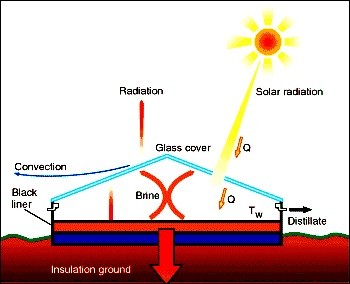Solar Distillation
There is an important need for clean, pure drinking water in many developing countries. Often water sources are brackish (i.e. contain dissolved salts) and/or contain harmful bacteria and therefore cannot be used for drinking. In addition, there are many coastal locations where seawater is abundant but potable water is not available. Pure water is also useful for batteries and in hospitals or schools.
Distillation is one of many processes that can be used for water purification. This requires an energy input, as heat, solar radiation can be the source of energy. In this process, water is evaporated, thus separating water vapour from dissolved matter, which is condensed as pure water.

Energy requirements for water distillation
The energy required to evaporate water is the latent heat of vaporisation of water. This has a value of 2260 kilojoules per kilogram (kJ/kg). This means that to produce 1 litre (i.e. 1kg since the density of water is 1kg/litre) of pure water by distilling brackish water requires a heat input of 2260kJ. This does not allow for the efficiency of the heating method, which will be less than 100%, or for any recovery of latent heat that is rejected when the water vapour is condensed.
It should be noted that, although 2260kJ/kg is required to evaporate water, to pump a kg of water through 20m head requires only 0.2kJ/kg. Distillation is therefore normally considered only where there is no local source of fresh water that can be easily pumped or lifted.
How a simple solar still operates
Figure 1 shows a single-basin still. The main features of operation are the same for all solar stills. The incident solar radiation is transmitted through the glass cover and is absorbed as heat by a black surface in contact with the water to be distilled. The water is thus heated and gives off water vapour. The vapour condenses on the glass cover, which is at a lower temperature because it is in contact with the ambient air, and runs down into a gutter from where it is fed to a storage tank.
Solar distillation Practical Action 2
Design objectives for an efficient solar still
For high efficiency the solar still should maintain:
- a high feed (undistilled) water temperature
- a large temperature difference between feed water and condensing surface
- lowvapour leakage.
A high feed water temperature can be achieved if:
- a high proportion of incoming radiation is absorbed by the feed water as heat. Hence low absorption glazing and a good radiation absorbing surface are required
- heat losses from the floor and walls are kept low
- the water is shallow so there is not so much to heat.
A large temperature difference can be achieved if:
- the condensing surface absorbs little or none of the incoming radiation
- condensing water dissipates heat which must be removed rapidly from the condensing surface by, for example, a second flow of water or air, or by condensing at night.
solar-distillation-7534-eIywQXO.docx (1628 KB)
solar-distillation-7534-lqSipkj.ppt (9758 KB)

